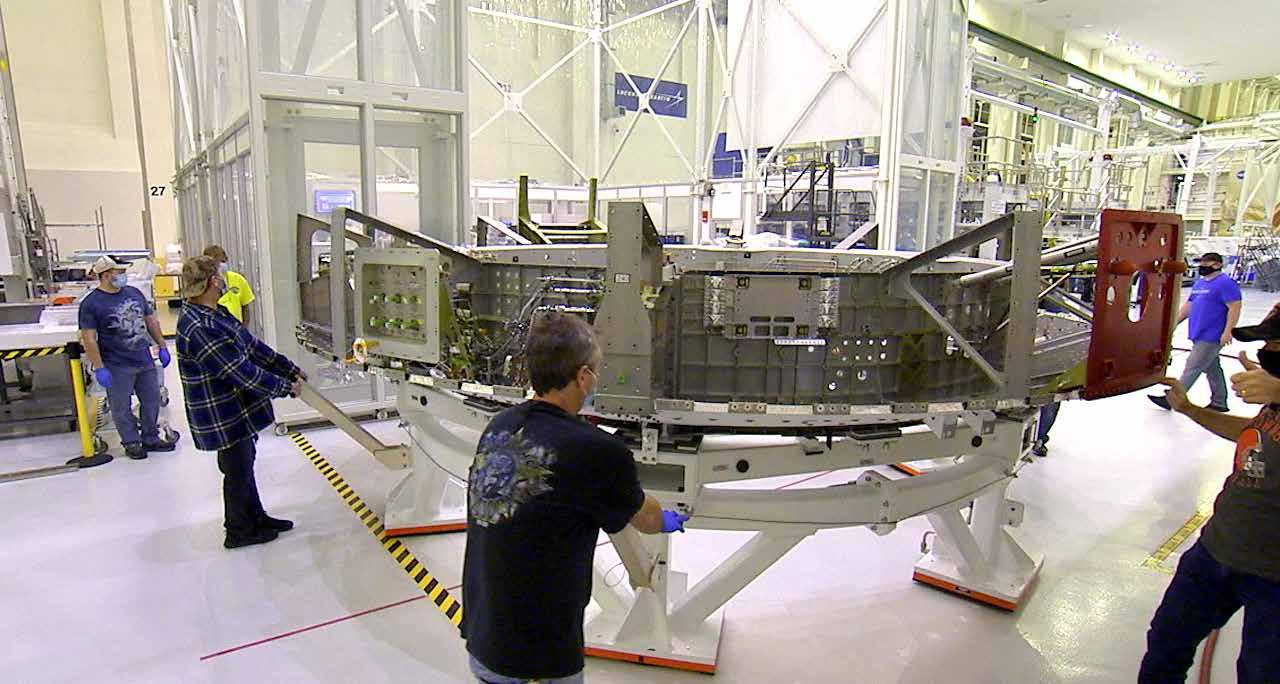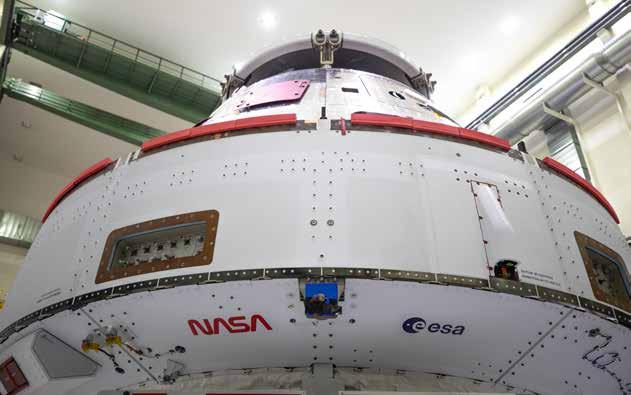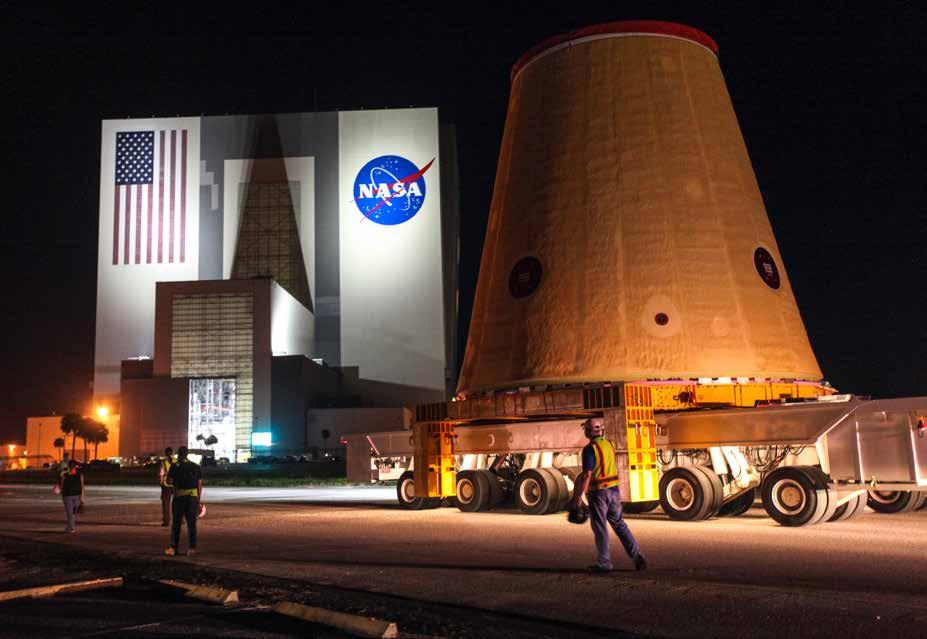
14 minute read
Artemis Program Timeline Exploration Ground Systems Orion Production Operations Space Launch Systems Gateway Deep Space Logistics
ARTEMIS PROGRAM: Accelerating Toward a 2024 Moon Landing
NASA is charged with the extraordinary mission of putting the first woman and next man on the Moon by 2024. In the past year, Kennedy Space Center has been a hub of critical activity progressing toward that monumental mission. The dedicated, mission-focused members of the Exploration Ground Systems, Orion, and Space Launch System (SLS) programs, along with the Gateway Deep Space Logistics team, accomplished significant milestones during fiscal year 2020 that included spacecraft assembly, preparing the ground support systems, priming the launch team, receiving rocket segments, and building the deep space commercial supply chain that will support the astronauts in their arrival and landing on the Moon and venture beyond to Mars.
Advertisement
NOV 2019
Orion crew and service modules for Artemis I are transported to NASA’s Plum Brook Station in Sandusky, Ohio, for environmental testing to certify they are ready for flight DEC 2019
Validation and verification are completed on the mobile launcher swing arm, Pad 39B xenon lights, and the fire suppression system JAN 2020
SLS pathfinder booster segment lifting practice
Gateway Deep Space Logistics provides the keynote address at the Air Cargo Conference FEB 2020
Firing room simulations and cryogenic fueling countdown are completed MAR 2020
SpaceX announced as first awardee under the Gateway Logistics Services contract
Landing and Recovery Team validates Orion recovery procedures during Underway Recovery Test-8
Orion spacecraft returns to Kennedy aboard NASA’s Super Guppy aircraft and is transported back to the Neil Armstrong Operations and Checkout Building high bay for final production processing for Artemis I APR 2020
Artemis II Launch Abort System jettison motor arrives
MAY 2020
Launch Pad 39B ready for Artemis I JUNE 2020

Artemis II Orion crew module and crew module adapter assembly progresses
SLS booster segments and aft skirts arrive JULY 2020
Artemis II heatshield progresses
SLS rocket launch vehicle stage adapter arrives AUG 2020
Artemis I spacecraft adapter cone installation SEP 2020
Artemis I solar array wing deployment and inspection
‘NASA Worm’ installation on flight hardware
Exploration Ground Systems
Orion Production Operations
Space Launch System
Gateway Deep Space Logistics
ARTEMIS COMPONENTS: Exploration Ground Systems

Exploration Ground Systems (EGS) has moved from the planning and development phase into operations for the Artemis I mission. Much of the hardware for the first flight has arrived and is in processing to prepare for launch in 2021. EGS has only yet to receive the core stage of the Space Launch System (SLS) rocket and the official handover of the Orion spacecraft. Stacking will take place in the next fiscal year, starting with the booster rockets on the mobile launcher in High Bay 4 of the Vehicle Assembly Building (VAB).
Validation and verification completion
• The mobile launcher – the 380-foot-tall ground structure that will be used to assemble, process, and launch SLS – completed integrated testing inside the VAB and at newly renovated Launch Pad 39B, validating it can communicate effectively with the facility systems and ground systems to perform appropriately during launch. • These tests included a swing arm test of the umbilicals, aiming of Xenon lighting, and a demonstration of the fire suppression and cryogenic fueling systems.
The cross-country line through which liquid oxygen will flow stretches from the storage tank to the mobile launcher at Launch Pad 39B on Nov. 8, 2019. Exploration Ground Systems oversaw testing of the pad’s cryogenic systems in preparation for the launch of SLS and Orion spacecraft for the uncrewed Artemis I mission.

SLS pathfinder booster segment practice
• The EGS team, including engineers, technicians, and crane operators with contractor Jacobs, practiced lifting and stacking operations with pathfinder segments of Northrop Grumman’s solid rocket boosters. • These sections of the SLS rocket will be stacked in High Bay 4 of the VAB. • Stacking rehearsals prepare the team by using pathfinder segments – inert, full-scale replicas of the actual solid rocket boosters, with the same weight (300,000 pounds) and center of gravity.
In High Bay 4 of Kennedy’s Vehicle Assembly Building, a team of engineers with Exploration Ground Systems and contractor Jacobs participate in Space Launch System (SLS) solid rocket booster pathfinder stacking during a training exercise on Jan. 8, 2020.

Members of NASA’s Landing and Recovery Team, along with Navy sailors from the USS John P. Murtha and divers from EOD Mobile Unit 3, MDS Company 3-1, attach tending lines to a test version of Orion during Underway Recovery Test-8 off the coast of California, March 13, 2020. Underway Recovery Test-8
• NASA, the U.S. Air Force’s 45th Space Wing Human Space Flight Support Office, the U.S. Navy, and Orion prime contractor Lockheed Martin conducted the Underway Recovery Test-8 (URT-8) in March 2020.
• The combined team has been conducting a series of tests off the coast of California to practice recovery with a mockup of the Orion spacecraft. • For URT-8, the team performed an end-to-end mission simulation and validation of operational timelines.

Artemis I Launch Director Charlie Blackwell-Thompson (left) stands at the launch console inside the Launch Control Center’s Firing Room I at the Kennedy Space Center in Florida during a countdown simulation, Feb. 3, 2020. Next to her are Jessica Parsons, former technical assistant to the launch director, and Jeremy Graeber, NASA’s Test, Launch and Recovery Operations branch chief, who also serves as the assistant launch director.
• The Artemis I launch team continues to prepare for launch with a series of simulations. In February 2020, the team conducted a realistic run-through of the terminal count – the final stretch of the countdown that ends with booster ignition. • In late summer, the team focused on loading fuel into the SLS rocket with a cryogenic simulation. • During a simulation, a small group of masterminds introduces anomalies and other unexpected situations that controllers and launch managers must solve in real time.

Launch Pad 39B ready for Artemis I
• In May 2020, Launch Pad 39B was declared ready for Artemis I. • Throughout the past few years, EGS has modified and upgraded Launch Complex 39B for the SLS rocket and Orion spacecraft. • New fiber cable and a water tower for the upgraded sound suppression system passed integration testing. Refurbishments were completed on the pad’s three lightning towers, and a new flame deflector was installed.
In this aerial view of Launch Complex 39B, Exploration Ground Systems’ mobile launcher for the Artemis I mission is in place on the pad. In May 2020, Launch Pad 39B was declared ready for Artemis I.
Inside Kennedy’s Rotation, Processing and Surge Facility, Exploration Ground Systems and Jacobs TOSC workers completed painting of NASA’s “worm” logo on the Artemis I Space Launch System twin solid rocket boosters on Sept. 23, 2020.

ARTEMIS COMPONENTS: Orion Production Operations
Fiscal year 2020 proved to be a dynamic time for the Orion production team of engineers and technicians at Kennedy Space Center. The march toward final preparations for the uncrewed and crewed flight tests atop the agency’s Space Launch System (SLS) rocket on Artemis I and II missions included several milestone achievements that spanned across facilities, including the Neil Armstrong Operations and Checkout Building (O&C) high bay and the Launch Abort System Facility.
Artemis I crew and service module (CSM) environmental testing and return to Kennedy
• Successful environmental testing at NASA’s Plum Brook Station in Ohio verified NASA’s Orion spacecraft can handle the extreme conditions of a deep-space environment. The spacecraft returned to the Florida spaceport for final testing and assembly and is certified for Artemis missions. • Orion demonstrated it could handle the extreme temperatures of space during thermal vacuum testing, simulating sunlight and shadow the spacecraft will encounter during flight. During this test, the spacecraft was exposed to temperatures ranging from -250 to around 200 degrees Fahrenheit. • Electromagnetic interference and compatibility testing verified all of Orion’s electronics work correctly when operating simultaneously and in the electromagnetic environments it will encounter during its mission. • Sealed in a protective shipping container, the Artemis I CSM returned to Kennedy in March 2020, arriving at Kennedy’s Launch and Landing Facility aboard the agency’s Super Guppy aircraft. The spacecraft then was transported to the O&C. • Orion will go through a final round of testing and assembly, including end-to-end performance verification of the vehicle’s subsystems, checking for leaks in the spacecraft’s propulsion systems, installing its solar array wings, performing spacecraft closeouts, and pressurizing a subset of its tanks in preparation for flight.
NASA’s Orion spacecraft, protected in its shipping container, is removed from the agency’s Super Guppy aircraft at Kennedy’s Launch and Landing Facility runway on March 25, 2020, after returning from testing at the agency’s Plum Brook Station in Ohio.


The Artemis II crew module adapter is relocated from the clean room to the Proof Pressure Cell inside the Neil Armstrong Operations and Checkout Building at Kennedy. Artemis II crew module and crew module adapter processing
• The crew module moved between workstation and clean room in June 2020 to perform tube welds of the propulsion system and the Environmental Control and Life Support Systems. • The crew module adapter moved between clean room and Pressure Proof Cell for additional maintenance and testing.

Inside Kennedy’s Neil Armstrong Operations and Checkout Building high bay, the Artemis II crew module is relocated into a clean room on June 10, 2020.

The launch abort motor is integrated with the jettison motor for Orion’s launch abort system for Artemis II inside Kennedy’s Launch Abort System Facility on April 15, 2020. Photo credit: Lockheed Martin Artemis II Launch Abort System (LAS) mating with jettison motor
• Kennedy received a critical piece of hardware in support of the Artemis II crewed mission, the LAS motor, in April 2020. • The launch abort motor was integrated with the jettison motor for Orion’s LAS for Artemis II in April 2020 inside Kennedy’s Launch Abort System Facility. • The launch abort motor is one of three motors on the LAS and is capable of producing about 400,000 pounds of thrust to steer and pull the crew module away from the rocket. The attitude control motor and the jettison motor complete the trio of motors responsible for controlling the LAS.
Artemis II heat shield progress
• Technicians at Kennedy finished meticulously applying more than 180 blocks of ablative material to the heat shield for the Orion spacecraft set to carry astronauts around the Moon on Artemis II.
• Ablative material called AVCOAT was produced at the agency’s Michoud Assembly Facility in New Orleans. It was then shipped to Kennedy and machined into 186 unique smaller blocks before being applied by the technicians onto the heat shield’s underlying titanium skeleton and carbon fiber skin.
• Engineers conducted non-destructive evaluations to look for voids in the bond lines, as well as measure the steps and gaps between the blocks. The gaps will be filled with adhesive material and then reassessed. The heat shield will then undergo a thermal test after which it will be sealed, painted, and then taped to help weather in-orbit thermal conditions. Once all testing has been completed, the heat shield will be installed and bolted to the crew module later this year.

Technicians with ASRC Federal inspect AVCOAT block bonding on the Artemis II heat shield inside Kennedy’s Neil Armstrong Operations and Checkout Building on July 2, 2020.
Artemis I spacecraft adapter cone installation
• The spacecraft adapter cone was attached to the bottom of the spacecraft’s service module in August 2020.
• This piece connects to the bottom of Orion’s service module and will later join another adapter connected to the top of the rocket’s interim cryogenic propulsion stage (ICPS). • The Orion spacecraft was lifted out of the Final Assembly and Systems Testing (FAST) cell and placed into the Super Station support fixture, then returned to the FAST cell following installation. The Artemis I Orion spacecraft, with its spacecraft adapter cone attached, is moved by crane along the high bay inside Kennedy’s Neil Armstrong Operations and Checkout Building on Aug. 20, 2020.

(Right) The final of four solar array wings is shown being installed prior to receiving its protective covering on the Orion spacecraft for Artemis I, Sept. 30, 2020.
(Below) NASA’s “worm” logo and European Space Agency (ESA) are visible on the aft wall of Orion’s crew module adapter, Sept. 24, 2020.
• Teams from NASA, Lockheed Martin, the European Space Agency (ESA), Airbus Defence, and Airbus Netherlands completed the installation of Orion’s four solar array wings on the European-built service module in September 2020.
• Prior to installation, the ESA/Airbus teams unfurled each array and performed an inspection to confirm proper extension and to ensure all the mechanisms functioned as expected.
• The solar array wings will provide energy to the service module, which in turn will power and propel the spacecraft.


• Teams at Kennedy applied the historic “worm” logo in bright red on visible parts of the Artemis I spacecraft and rocket. The sleek design was first added to the SLS twin solid rocket boosters in August 2020; in September, the logo was added to the aft wall of Orion’s crew module adapter.
• Originally created by the firm of Danne & Blackburn, the “worm” logo was officially introduced in 1975. It was retired in 1992 but has made a comeback in 2020 as the agency ushers in a new, modern era of human spaceflight.
ARTEMIS COMPONENTS: Space Launch System
Kennedy Space Center ramped up production of NASA’s Space Launch System (SLS) rocket during fiscal 2020. Throughout the year, Exploration Ground Systems (EGS) received SLS rocket hardware and commenced ground processing for Artemis I.
SLS booster segments and aft skirts arrival
• In June 2020, EGS received the two, five-segment solid rocket motor assemblies of the SLS rocket for Artemis I.
• The motor assemblies arrived by train from a Northrop Grumman manufacturing facility in Promontory, Utah, and were taken to Kennedy’s Rotation, Processing and Surge Facility (RPSF) for inspection, processing, and storage until stacking operations. • The aft skirts also were delivered from the Booster Fabrication Facility to the RPSF for mating with the aft segments in preparation for stacking.

Twin rocket boosters for NASA’s Space Launch System that will power Artemis missions to the Moon arrive at Kennedy on June 15, 2020. The two motor segments, each comprising five segments, arrived by train from a Northrop Grumman manufacturing facility in Promontory, Utah. Left: Technicians lift the right aft motor segment – one of five segments that make up one of two solid rocket boosters for the agency’s Space Launch System – onto an inspection stand inside Kennedy’s Rotation, Processing and Surge Facility on June 23, 2020.

SLS launch vehicle stage adapter arrival
• The second-to-last piece of hardware for Artemis I arrived at Kennedy in July 2020 aboard NASA’s Pegasus barge. The launch vehicle stage adapter (LVSA) connects the SLS core stage to the upper stage, called the Interim Cryogenic Propulsion Stage. • The cone-shaped connector also helps protect the RL10 engine housed in the upper stage, which will provide the power necessary to leave Earth’s orbit and send the Orion spacecraft on its journey to the Moon.
Right: Technicians with NASA’s Exploration Ground Systems move the launch vehicle stage adapter for the agency’s Space Launch System rocket off of the Pegasus barge for transportation to Kennedy’s Vehicle Assembly Building on July 30, 2020.

Left: Technicians with NASA’s Exploration Ground Systems move the launch vehicle stage adapter for the agency’s Space Launch System rocket from Kennedy’s Launch Complex 39 turn basin to the Vehicle Assembly Building on July 30, 2020.









